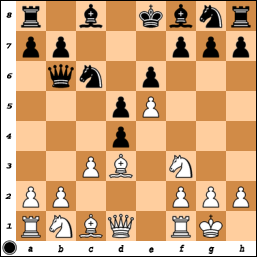White offers two pawns - only one is usually taken - for an attack that can be quickly deadly at club level.
I can remember winning a game, long before I had played in my first tournament, after the moves 1.e4 e6. 2.d4 d5 3.e5 c5 4.c3 Nc6 5.Nf3 Qb6 6.Bd3 cxd4 7.cxd4 Nxd4?? (there are 71 examples of this move since 1991 in ChessBase's 2020 Mega database) 8.Nxd4 Qxd4?? 9.Bb5+ etc.
The players on the black side of this line in Mega20 include three rated over 2000.
As is well-known (but not by everyone, clearly) Black should prefer 7...Bd7, after which Nimzowitsch used to play the sorry-looking 8.Be2, although he managed to beat Tarrasch and Duras from this position in a tournament in 1912.
Nimzowitsch's heroics not withstanding, the position after 8.Be2 is a tempo down on one that can be reached after 6.Be2.
The Milner-Barry Gambit, named after London player and WW2 code-breaker Sir Stuart Milner-Barry, starts with White playing 8.0-0!?, thus ignoring the threat to the d4 pawn that became real after 7...Bd7.
 |
| Starting point of the Milner-Barry Gambit |
Black then has to decide between grabbing a second pawn with 10...Qxe5, or declining it, normally with 10...a6.
Gligorić and Uhlmann in Understanding The Chess Openings - The French Defence (RHM Press 1975) say taking the second pawn is "extremely risky."They give 10...a6 an exclamation mark, saying the single-pawn sac is a gambit "which theory considers insufficient but which practice has shown to be not without danger."
French Defence expert Uhlmann gave similar verdicts in Winning With The French (Batsford 1995*) although, if anything, he was more complimentary about the gambit, calling it "certainly a dangerous weapon in the hands of an experienced attacking player," and again giving 10...a6 an exclamation mark.
However, by the time another French expert, US international master John Watson, wrote the third edition of Play The French (Everyman 2003), the theoretical tide had turned against Sir Stuart's pet line, Watson's verdict being: "It has now been relegated to a rare sideline."
Since then Topalov has beaten Morozevich with it at the world blitz championship, and Smerdon has used it at regular time controls (drawing with Akopian, losing to Sadler), but generally speaking it is probably fair to say most players agree with Watson.
Certainly modern analysis engines, including Stockfish12 and Komodo11.01, reckon Black has the upper hand after the much-praised 10...a6 (but reckon 10...Qxe5 leads to dead equality).
At this point it is time to introduce the "New & Improved" Milner-Barry in the shape of 7.0-0!?
 |
| Starting point of the New Milner-Barry Gambit |
The first game featuring two rated players came two decades later.
Philippe Langevin (2180) - Yann Marteau (2317)
French Team Championship 2000
1.e4 e6 2.d4 d5 3.e5 c5 4.c3 Qb6 5.Nf3 Nf6 6.Bd3 cxd4 7.0-0!? Bd7!?
There are only eight games in Mega20 with the critical 7...dxc3.
Watson, in his November French Defence update at chesspublishing.com, writes: "Since White has obvious compensation after 7...dxc3 8.Nxc3 (compare the main lines of the Milner-Barry), strong players of Black have traditionally chosen 7...Bd7."
No doubt this is true, although even 7...Bd7 has only 42 games in Mega20 (but then Watson almost certainly has a larger personally-compiled database).
A major problem in deciding on the merits of 7...dxc3 is that it appears in only two games in which both players were rated, and even then only one of the players in those games was rated over 1775.
I will try later, with the help of Stockfish12 and Komodo11.01, to give some idea of what is going on.
Meanwhile, back to Langevin - Marteau.
8.a3!?
Giving Black a second chance to capture on c3.
The Swedish grandmaster Jonny Hector has had success with 8.Re1!?, while Magnus Carlsen recently beat Harikrishna with 8.Nbd2!? I will look at their games later.
Note that 8.cxd4 transposes to a regular Milner-Barry Gambit.
8...a5!?
White has good compensation for a pawn after 8...dxc3 9.Nxc3, according to the engines. They give best-play as 9...Nge7 10.Be3 Qd8 (10...Qxb2? 11.Nb5 is very strong for White), which is unclear but dangerous for Black, eg 11.Bg5 h6? 12.Nb5 wins for White.
9.cxd4
Retaking the pawn, at least temporarily, and reaching a mainline position of the French Advance which more often comes about from the move-order 6.a3 a5 7.Bd3 Bd7 8.0-0!? cxd4 9.cxd4.
9...Nxd4 10.Nxd4 Qxd4 11.Nc3 Qb6
It would be fascinating to learn if either Langevin or Marteau knew they were following fairly-mainline theory (Korchnoi had played 11...Qb6 two years earlier, and later in 2000 it was played by Anand).
12.Nb5?!
Most strong players, including Shirov, have applied kingside pressure with 12.Qg4.
12...Bxb5 13.Qb3
This is the 'clever' point of White's play. He will regain his piece, but meanwhile Black has swopped off his traditionally bad light-square bishop.
13...Ne7?!
This looks natural but almost certainly better is 13...Bc5 14.Bxb5+ Kf8, as in Srđan Benderać (2356) - Milan Vukić (2491), Bosnia & Herzegovina Team Championship (Jahorina) 2003, when the engines reckon Black is slightly better (but 1-0, 32 moves).
14.Be3 a4?
Better is 14...Qc7 15.Bxb5+ Nc6, although the engines agree White has at least enough compensation for a pawn.
15.Bxb5+ Nc6 16.Qxd5 Qc7 17.Qc4
White has got his pawn back while still having the 'compensation' of more-active pieces and queenside pressure.
17...Be7 18.f4 0-0
There is no way to defend a4.
19.Bxa4 Rfc8 20.Rac1 Qa5 21.Bb3 Bd8
Not 21...Nxe5?? 22.Qxc8+ Rxc8 23.Rxc8+ Bxf8 24.fxe5 Qxe5 25.Bc5 with a massive material advantage.
White went on to win in 52 moves.
*A translation of a German book published four years earlier.
No comments:
Post a Comment